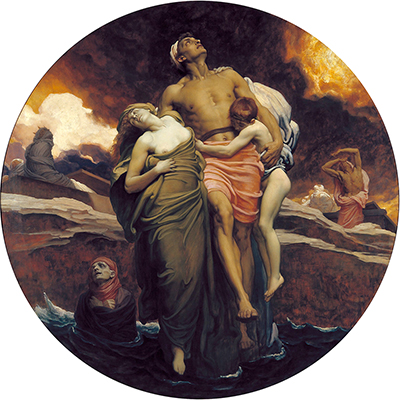The full name of this painting is And the Sea Gave Up the Dead Which Were in It, and it was originally supposed to be representative of apocalyptic themes. The dramatic scene is based upon the Book of Revelation, and was painted by Lord Frederic Leighton in 1892.
Leighton, also called Sir Frederic Leighton, was a British sculptor, draughtsman and painter who died in 1896. This work is typical of his later works, very solemn and dark yet with an element of hope. The piece was originally destined to be a roundel decorating the spandrels of St Paul's Cathedral's dome, in London. Eight roundels would depict the apocalypse in different stages, as told with the aforementioned book of revelations. Leighton’s piece, although sombre and full of contrasting fire and darkness, actually heralds the resurrection stage of the rapture: And the sea gave up the dead which were in it; and death and hell delivered up the dead which were in them: and they were judged every man according to their works. The figures in the scene rise up from the sea, inexorably drawn towards the heavens.
Recently dead, their skin shows different levels of pallor to indicate their meagre connection to the world of the truly living. These are half-lives, languishing in the ocean for eternity and only now given a chance at salvation. Leighton's piece was never used in St Paul's as it was eventually decided that the apocalyptic scenes were not, in fact, what the church needed at that time. Only a preliminary sketch was ever hung there. However, Henry Tate (of the Tate Gallery) was keen to add the concept to his then brand new collection of contemporary art. The style and uninhibited drama of the finished piece indicate inspiration from other designers of great, religious houses, such as Raphael and Michelangelo.
Leighton used oil on canvas to create the tondo, and was very clever in his use of colour. The skin tones are reflected in the clouds to either side of the central group, yet the dark plumes behind the central group allow the figures to stand out as the focus for the viewer. Shades of red in a headscarf are reflected in boiling waves.It can be presumed that the group of three is a family clinging together, the boy and woman still slumbering but the man looking upwards as if beseeching God to rescue them.
Perhaps as Leighton neared the end of his own life, he considered his own mortality and the possibility for salvation. He certainly captured the yearning for mercy and forgiveness in this piece. And the Sea Gave Up was apparently Leighton's own personal favourite of his designs, despite a mediocre reception during his lifetime. Critics noted that it was oppressive and cold, although they reflected that the themes within showed a high intellect and philosophical frame of mind.




